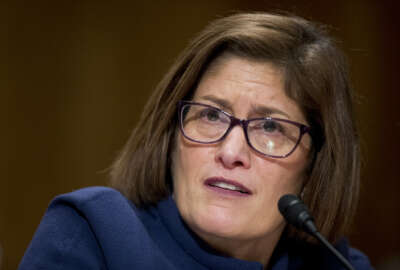
Senate committee kicks off series of hearings on civil service reform
The Senate Homeland Security and Governmental Affairs' federal workforce subcommittee said it's on a fact-finding mission this year. Subcommittee Chairman James...
The Senate Homeland Security and Governmental Affairs’ federal workforce subcommittee is on a fact-finding mission this year — with the intent of finding new ideas to modernize the civil service.
“I consistently hear people say, ‘We need to address the GS system.’ And right behind it they say, ‘And that will be the most painful experience the federal government’s taken on in decades. I would never ever touch it if I was you,'” Sen. James Lankford (R-Okla), the chairman of the Senate Homeland Security and Governmental Affairs Subcommittee on Regulatory Affairs and Federal Management, said during a Feb. 9 hearing on the federal workforce. “But we need to do it.”
It was the first of several hearings the subcommittee has planned this year to examine federal hiring, discipline and performance management.
The hearing comes several weeks after President Donald Trump authorized a short-term hiring freeze for some federal employees. The freeze will end when the Office of Management and Budget develops a long-term plan to reduce the size of the federal workforce through attrition.
“Attrition through a hiring freeze may not be the optimal solution for creating an efficient and effective federal workforce, but in the absence of any notable legislation reforms to improve the federal workforce, the administration has every right to alter the status quo through an executive action,” Lankford said. “Congress can either watch as the administration deals with the federal workforce through executive actions, or it can find consensus and work with the administration, take up the mantel of substantive legislative reform.”
What that legislative reform looks like is still unclear, and opinions vary. Yet federal employee associations and unions said they’re ready to work with Congress.
Lankford said he wants to hear from federal managers about the existing authorities and processes that make their jobs more difficult. That could lead to new training programs or initiatives — or new legislation.
“[Do] current laws give federal managers the adequate authority to manage the federal workforce or [are] new laws needed to expand their authority? The answer is clear: no new laws are needed,” Cox said.
Cox was the only one of the witnesses to explicitly dismiss the idea of new legislation. But in many ways, there’s already consensus within the federal community about the problems.
The General Schedule, a by-product of the 1950’s, is outdated. The Civil Service Reform Act is nearly 40 years old. The hiring process, which averaged 100 days in 2016, takes too long. And though opinions on the disciplinary appeals process vary, most agree that it’s too complicated.
For Lankford, improving the hiring process is the first place to start.
“The hiring is the most important part of it,” he said. “You don’t have as many issues with firing and with oversight if you have good hiring. That involves managers getting a good list, working with HR to make sure that everyone knows exactly what you’re looking for, getting that in place so when they go through the process, they actually get the right person at the beginning.”
Agencies have at least 105 different hiring authorities to bring on new talent. Yet most organizations used 20 of them to make 90 percent of their new hires in 2014.
The Office of Personnel Management spent most of 2016 traveling to agency field offices across the country under its Hiring Excellence campaign. The goal was to better educate HR specialists and hiring managers about the wide variety of authorities and flexibilities they already have to recruit and hire new talent.
But Bob Corsi, former assistant deputy chief of staff for manpower, personnel and services for the Air Force, said OPM needs to do more.
“You have to require that organizations have a human capital strategy, a strategic plan, which forces them to look at the current workforce, what’s coming down the pike and require them to use analytics to get really smarter on the front end of this so they can actually get the right talent,” he said.
Yet as some have argued, the problem goes deeper than that. Most agencies lack the human resources talent they once had to lend their expertise and help agency managers solve employee problems.
“No corporation in the world would have a human resources office that does not serve as the principle advisor to its operating units on issues like hiring, on issues like separation,” Valdez said. “Unfortunately, what’s happened with OPM is that they delegated much of the authorities to the agencies on transactional issues, how you hire, etc. But there wasn’t a concurrent upgrading of OPM to serve as that corporate advisor.”
Most federal managers simply can’t digest and understand Title 5 or the hundreds of pages of OPM guidance, Valdez said, holding up thick bounds of the agency’s written material for the subcommittee to see.
“They should be providing to agencies advice about how to manage their workforces and make it easier for them to do that,” Valdez said.
Poor performers
Dealing with poor performers has been a sticking point for many members of Congress in recent years, who argue that agency managers often fail to deal with poor performers and when they do, it simply takes too long to fire them.
“When poor performers are not dealt with, it is never because the civil service laws or procedures are too difficult to navigate, but rather because some managers either do not want to take the time and effort to properly document poor performance and remove or demote poor performers or because they lack the knowledge, skills and ability to do that,” Cox said in his written testimony.
Most senior executives and managers aren’t held accountable in their own performance reviews to make sure they deal with poor performers properly, a point that Lankford said he hoped to discuss with OPM.
“It is considered to be too much trouble to deal with poor performers,” Valdez said. “You have so many constraints on your time that you just want to make these things go away.”
Others argued that extending the probationary period from one year to two would help managers get a better handle on an employee’s performance.
Yet Sen. Heidi Heitkamp (D-N.D.) disagreed.
“It would never have taken me two years to know that I had somebody I didn’t need in my workforce,” she said. “To suggest that this is the end-all and be-all is problematic to me. It may in fact be that this person would be a wonderful person with the right supervisory skills could in fact emerge as one of the best employees you have.”
Heitkamp said she planned to reintroduce the Federal Supervisor Training Act this Congress. The bill would give senior executives and supervisors more clear guidelines on best management practices.
But nearly all the witnesses agreed: not every high-performing employee is destined for federal management.
“We bring people in on a technical side,” said Renee Johnson, national president for the Federal Management Association. “They’re very good at that. We move them into management and they may not have management skill sets to be successful in managing, but they feel like that’s the only way they can continue to progress their careers.”
Copyright © 2025 Federal News Network. All rights reserved. This website is not intended for users located within the European Economic Area.
Nicole Ogrysko is a reporter for Federal News Network focusing on the federal workforce and federal pay and benefits.
Follow @nogryskoWFED





